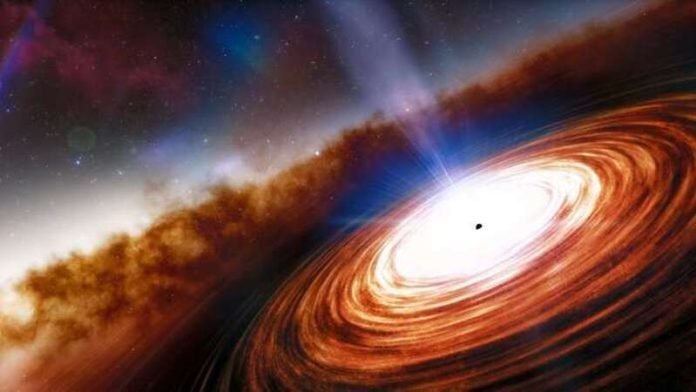
The most luminous quasar, known as SMSS J114447.77-430859.3 or simply J1144, has been observed in X-ray emissions.
This observation provides a fresh understanding of how quasars function and interact with their surroundings.
The exciting details have been published in the Monthly Notices of the Royal Astronomical Society.
J1144: A Bright Beacon in the Cosmos
J1144 is nestled in a galaxy situated 9.6 billion light years away from Earth, nestled between the constellations of Centaurus and Hydra.
Its brightness is staggering, outshining the Sun by 100,000 billion times. What makes J1144 especially interesting is its relative proximity to Earth, when compared to other luminous sources.
This enables astronomers to study the black hole powering this quasar and its immediate surroundings more closely.
Team Behind the Study
The study was led by Dr. Elias Kammoun, a postdoctoral researcher at the Research Institute in Astrophysics and Planetology (IRAP), and Zsofi Igo, a Ph.D. candidate at the Max Planck Institute for Extraterrestrial Physics (MPE).
Understanding Quasars
Quasars rank among the brightest and most distant entities in the known universe. They are fueled by gas falling into a supermassive black hole.
Quasars can be considered highly luminous active galactic nuclei (AGN) that emit huge amounts of electromagnetic radiation.
This can be observed across various wavelengths, such as radio, infrared, visible, ultraviolet, and X-ray. J1144 was initially observed in visible wavelengths in 2022 by the SkyMapper Southern Survey (SMSS).
The Methodology
The research team combined observations from several space-based observatories:
the eROSITA instrument on board the Spectrum-Roentgen-Gamma (SRG) observatory, the ESA XMM-Newton observatory, NASA’s Nuclear Spectroscopic Telescope Array (NuSTAR), and NASA’s Neil Gehrels Swift observatory.
They used the data from these observatories to determine the temperature of the X-rays emitted by the quasar, finding it to be approximately 350 million Kelvin – over 60,000 times hotter than the Sun’s surface.
The researchers also determined that the black hole at the heart of the quasar is around 10 billion times the Sun’s mass and is growing at a rate of about 100 solar masses per year.
Intriguing Findings
Interestingly, the X-ray light from J1144 varied over a few days – a rather unusual occurrence for quasars hosting black holes of this size, which usually fluctuate over months or years.
Furthermore, the team found that while some gas is consumed by the black hole, some is ejected in the form of powerful winds, which inject vast amounts of energy into the host galaxy.
Dr. Kammoun expressed his surprise at the fact that no previous X-ray observatory had observed this incredibly powerful quasar.
He highlighted how rare and unique J1144 is due to its luminosity and relative proximity to Earth.
Dr. Kammoun further disclosed that a new monitoring campaign for this quasar is set to begin in June, and more fascinating discoveries from this unique celestial object could be on the horizon.
The study was published in the Monthly Notices of the Royal Astronomical Society.
Copyright © 2023 Knowridge Science Report. All rights reserved.



